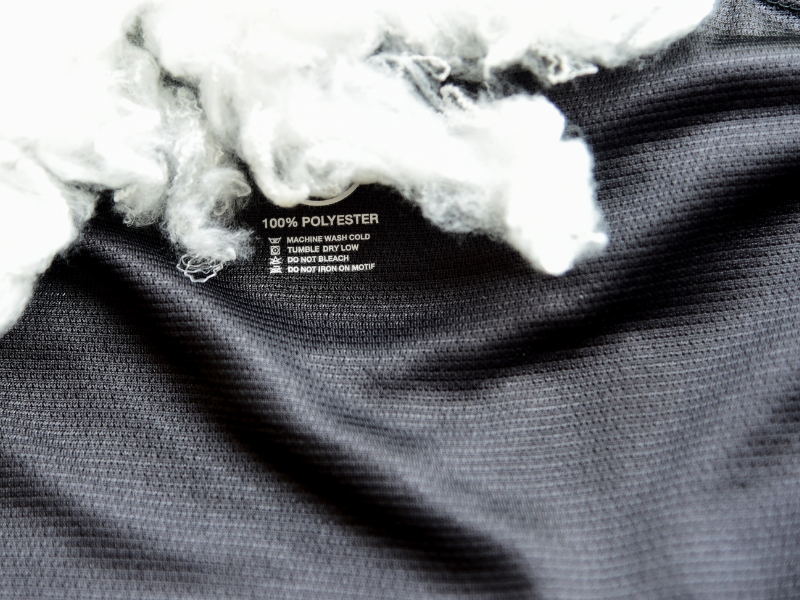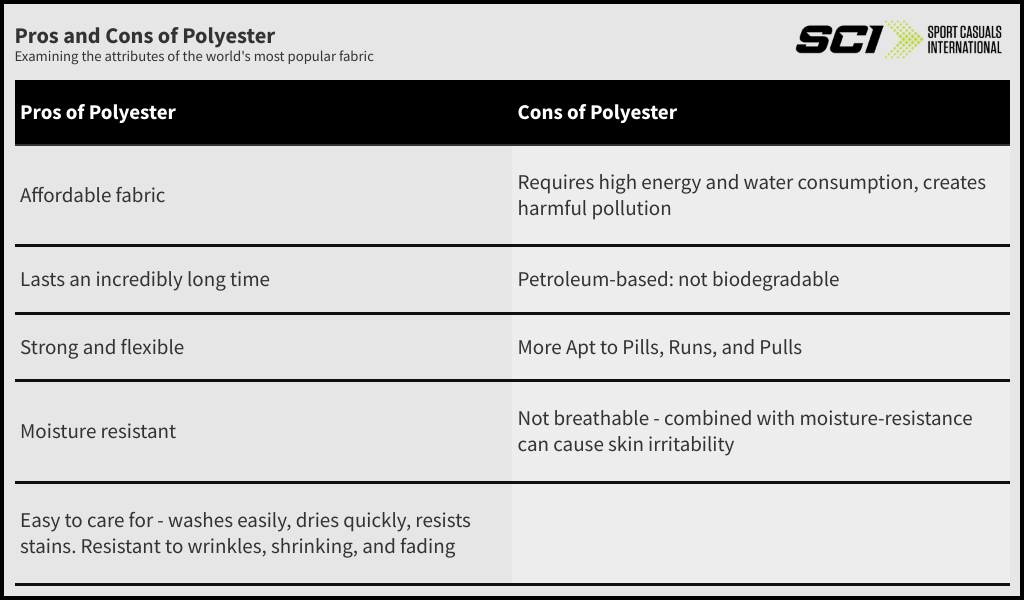Pros and Cons of Polyester - The Most Common Synthetic Fiber
There's no avoiding polyester. Thanks to the relative ease and low cost to produce it, polyester is a mainstay in the fast fashion industry. However, just because a fabric is easily accessible doesn't make it the right choice.
Polyester is the most prevalent fabric in the world, but behind every upside of polyester is followed by a steep downside. More on that in a minute.
This article will lay out the positives and negatives of polyester, then go into further detail on each factor. All to help you make a more informed sourcing decision for your activewear, athleisure, or general clothing brand.
What Are The Pros and Cons of Polyester?
The pros of polyester are mostly material, such as its strength, flexibility, moisture resistance, ease of care, and low cost. The cons of polyester are mostly environmental, such as high energy and water consumption, pollution, and inability to biodegrade.
But there are material cons as well, such as a higher likelihood of pilling, running, and pulling.
And since polyester isn't a breathable fabric, but is moisture resistant, this can leave wet spots on people, which can easily irritate people with sensitive skin.
From a material standpoint, the pros outweigh the cons in the mind of most manufacturers, brands, and consumers - because polyester is the most widely used fabric in apparel globally.
But from an environmental view, polyester is one of the worst textiles created, exacerbated by one of the worst categories for the planet already.
That's right, the clothing industry has a massive negative impact on the earth. For instance, 10% of the planet's carbon emissions are caused by the fashion industry.
How Do You Navigate The Pros and Cons of Polyester?
There are some choices you can make to amplify the upsides and minimize the downsides when sourcing polyester fabric or garments that require the material advantages of polyester.
But first, let’s cover why polyester rose to be the top choice for clothing manufacturers in the first place, and that starts with how it's made.
The Origin and Process of Creating Polyester
The original creation of polyester dates back to the 1940s when British chemists discovered they could create a durable plastic polymer through a chemical reaction of petroleum, water, and air.
Specifically, polyester fiber is made from polyethylene terephthalate or PET - if that looks familiar, it's most likely because you've seen it on single-use plastic water bottles, as it's the most common material for them.
In just a few steps, these molecules can become PET. Here's a grossly simplified overview:
The plastic pellets (see the image at the top of this article for what it looks like) are first created through a chemical process requiring high heat and pressure.
The plastic is then extruded through fine machinery to create long plastic fibers.
These threads are spun together to create polyester yarn/thread, that is either blended or remains intact.
The polyester is then most often knitted (it can be woven) into fabric form.
The fabric is then cut and sewn to create a polyester-based garment.
Polyester is a thermoplastic that can be heated and cooled into various shapes meaning it can be used in a wide variety of settings. While clothing may be the most common use for polyester, the material is also found nearly everywhere; in items like safety belts, home furnishings, and of course, plastic water bottles.
Price, Quality, and Speed Spurred Polyester's Adoption
The benefits that polyester offers clothing manufacturers are numerous, but most notably it's a very cheap fabric to produce.
In addition, it's much easier and faster to knit or weave polyester threads into fabric than natural fibers like cotton. This is because polyester is a man-made fiber as opposed to a plant-based one.
The quality of polyester has also increased over the years. The original polyester fabrics were quite stiff, but advances in technology have led to the development of softer, more flexible versions.
Polyester can now be made to feel and look like many natural fibers, which has only helped to increase its popularity.
All of these reasons - price, quality, and speed - have made polyester the number one choice for clothing manufacturers to use, especially in activewear and the athletic apparel space, since its quality and material advantages are far superior to what the natural options were at its inception.
Is Polyester Still Good For Clothing Today?
In terms of value, that is quality for cost, polyester is a great material for garments, as it's durable, water resistant, and holds its shape and color. This is likely a major reason polyester makes up over 50% of the total fiber market and over 80% of the synthetic fiber market.
There's a lot to like about polyester clothing as it relates to performance attributes:
Polyester fabric is durable: It tends to stretch without tearing, is resistant to abrasion and normal wear and tear, and doesn’t easily pill like other natural fibers.
Polyester fabric is water resistant: Don’t forget, polyester is a plastic and is therefore hydrophobic. When exposed to water, polyester generally repels the liquid causing droplets to form on the surface rather than absorbing moisture into the clothing.
Polyester fabric holds its shape and color: This is good for both clothing manufacturers and consumers. For the seller, textural elements like pleats can be added to clothing easily and polyester also takes on dyes very well. For the buyer, this means vibrant and wrinkle-resistant clothing.
While we’re still talking about the positives, it should also be noted that polyester blends very well with other natural or synthetic fiber choices.
It’s very common to find T-shirts made out of a cotton and polyester blend or yoga pants created from a combination of spandex and polyester. Polyester can add benefits to other fibers that wouldn’t otherwise be as strong or flexible as an example.
But there is one commonly cited reason why polyester clothing is uncomfortable. Polyester clothing is not breathable. Because polyester is a plastic material that keeps moisture out, clothing made out of 100% polyester can feel clammy and damp.
For similar reasons, polyester clothing also tends to hold odor and moisture inside rather than wicking away sweat or letting air flow through.
Comfort aside, the real dirt on polyester has to do with sustainability - or the lack thereof.
Is Polyester Clothing Eco-Friendly?
Polyester is not eco-friendly, as it's a petroleum-based product, which means it's not sustainable and takes hundreds of years to break down. In addition, the microfibers in polyester clothing often end up in our waterways where they're ingested by fish, other marine life, and humans as well.
Unfortunately, polyester is not a sustainable fabric choice, and therefore polyester clothing is not eco-friendly. Meaning the most widely used textile is not environmentally friendly.
You can see how this can easily get out of hand, and that's exactly what's happening. The real environmental impact of polyester should be considered from all angles. From the beginning of the process to the end.
Because polyester is harmful from sourcing to manufacturing, disposal, and waste - basically every decision at every step of the apparel supply chain. Damage to the earth tragically happens at all points along the way.
Con #1: Petroleum Problems
The first issue polyester can’t get around is that the material is made from petroleum and fossil fuels. Demand for polyester contributes to hundreds of millions of barrels of oil being extracted and refined from the earth.
Additionally, clothing brands find it difficult to transparently understand the source of their polyester - the practices or locations of where the oil came from are difficult to know or share with the consumer.
Con #2: Manufacturing Pollution
The process to create polyester also comes with its own set of problems.
While polyester is a relatively cheap material to manufacture, creating it still requires a lot of energy to be used. Additionally, toxic chemicals and heavy metals used in the manufacturing process can find their way into wastewater and ultimately the surrounding environment.
Con #3: Post-Manufacturing Pollution
Finally, once the polyester makes it onto shelves in the form of fabric or clothing, the environmental impact can still be felt. The problems here are twofold:
a) Microplastic Shedding
First, polyester clothing sheds microplastic as it is worn or washed. These microplastics ultimately make it into our water and soil sources and even inside our bodies. The scientific community is still learning about the full extent that microplastics can harm the earth and our bodies.
b) Landfill Fodder
Second, polyester clothing cannot be easily recycled and often ends up in landfills where it will sit for hundreds of years. Because polyester is a man-made plastic of sorts, it will not biodegrade and is not a sustainable resource.
Polyester is a Tragic Textile for the Planet
The use of cheap and accessible polyester fabric has contributed to environmental waste and bad habits throughout the entire garment industry - from fast-fashion everyday wear to athleisure and activewear.
Despite the impact, polyester is easy and profitable for clothing manufacturers to use, encouraging wasteful production and consumption patterns.
There is, however, one saving grace for polyester. Technology that preserves the functional benefits of polyester while lessening the environmental impact. That is recycled polyester or rPET.
How is Recycled Polyester Different From Virgin Polyester?
Recycled polyester is different from virgin polyester in terms of raw materials. Whereas virgin polyester requires new petroleum and chemicals to turn oil into plastic that can be weaved into clothing, recycled polyester is created from post-consumer PET water bottles that are transformed into polyester fabric.
To create recycled polyester, manufacturers will collect millions of pounds of used PET plastic from sources including single-use water bottles, fishing nets, and other industrial items.
The plastic will be washed, melted, and reformed into pellets or chips that can be processed further. At this point, the recycled polyester process will look very similar to the virgin polyester process - the rPET will be spun into long threads to create fabric.
Is There a Performance Difference in Recycled Polyester?
Recycled polyester behaves the same as virgin polyester fabric - strength, flexibility, moisture resistance, lightweight, ability to blend, ease of care - all of the performance attributes that brands and consumers love about virgin polyester are identical in recycled polyester.
This is all regardless of the form the PET takes post-consumer - be it a water bottle or packaging, your recycled polyester fabric will still have the same amazing performance qualities as virgin polyester.
The real benefit, however, is that by choosing recycled polyester clothing you will not be adding to new fossil fuel demand and will be helping save the environment.
Massive fashion brands have already replaced their dependency on virgin polyester with recycled polyester. Titans of fashion like Nike, Patagonia, The North Face, Levi's, etc., are all looking to manufacturers to source recycled polyester garments for them.
One standout manufacturer is Repreve, in unison with its parent company, which has recycled 34 billion PET water bottles to date - and this number shoots up by 4,300 bottles every minute.
Ditch Virgin Polyester, Adopt Recycled Polyester
Repreve, and more specifically recycled polyester, are in high demand. This is why the fabric has made the Sport Casuals' "5 Trending Eco-Friendly Fabrics in Activewear" list. But there's a long way to go.
Even if everyone used recycled polyester in place of polyester tomorrow, it's still not the most sustainable fiber on the market, not by a long shot. But it is a starting point for change.
Polyester will continue to be a fabric of choice for clothing makers because the material is inexpensive, easy to customize with colors and patterns, and creates durable and comfortable clothing.
While polyester clothing is common, consumers are waking up to the environmental impact it has, and this is affecting their purchase decisions. Setting aside the ethical charm of brands using recycled polyester, this adoption of recycled polyester by brands is most likely driven by consumer intent.
And since recycled polyester clothing has the same performance benefits as virgin polyester clothing with less harm to the environment, it's an easy decision even if there are cost implications, as they would be more likely tolerable due to positive environmental reasons.


